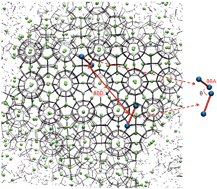The cages, dynamics, and structuring of incipient methane clathrate hydrates†
Abstract
Interest in describing clathrate

- This article is part of the themed collection: Physics and chemistry of ice and water
* Corresponding authors
a
Center for Hydrate Research, Chemical & Biological Engineering Department, Colorado School of Mines, Golden, CO
E-mail:
asum@mines.edu
b University of Arizona, Department of Aerospace and Mechanical Engineering, Tucson, AZ
c POSTECH-Pohang University of Science and Technology, Department of Chemical Engineering, Pohang, South Korea
d National Bioenergy Center, National Renewable Energy Laboratory, Golden CO
e Department of Chemistry, Colorado School of Mines, Golden, CO
Interest in describing clathrate

 Please wait while we load your content...
Something went wrong. Try again?
Please wait while we load your content...
Something went wrong. Try again?
M. R. Walsh, J. D. Rainey, P. G. Lafond, D. Park, G. T. Beckham, M. D. Jones, K. Lee, C. A. Koh, E. D. Sloan, D. T. Wu and A. K. Sum, Phys. Chem. Chem. Phys., 2011, 13, 19951 DOI: 10.1039/C1CP21899A
To request permission to reproduce material from this article, please go to the Copyright Clearance Center request page.
If you are an author contributing to an RSC publication, you do not need to request permission provided correct acknowledgement is given.
If you are the author of this article, you do not need to request permission to reproduce figures and diagrams provided correct acknowledgement is given. If you want to reproduce the whole article in a third-party publication (excluding your thesis/dissertation for which permission is not required) please go to the Copyright Clearance Center request page.
Read more about how to correctly acknowledge RSC content.
 Fetching data from CrossRef.
Fetching data from CrossRef.
This may take some time to load.
Loading related content
